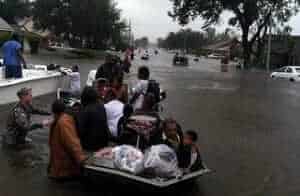
How does FEMA Respond to a Natural Disaster?
There are many different kinds of disaster types such as tornadoes, hurricanes, flooding, severe winter storms, and ice storms. When a disaster is declared it is the local government’s job to respond first with emergency services. The governor can request federal resources be mobilized through the U.S. Department of Homeland Security’s Federal Emergency Management Agency (FEMA) for search and rescue, electrical power, food, water, shelter and other basic human needs.
The President can declare a Major Disaster which then warrants supplemental federal aid. Additional funding is then provided by the President’s Disaster Relief Fund, which is managed by FEMA. Louisiana has had 60 Major Disaster Declarations and 10 Emergency Declarations over the past 50 years.
Over the last 50 years Louisiana has had 60 major disaster declarations, ranking Louisiana fifth in the number of overall major disaster declarations issued among all of the states. Every year some part of Louisiana is struck by a flood, hurricane, or severe storm. This is why it is so important that the residents of Louisiana be well-prepared, well-informed, and fully insured.
For a free legal consultation, call 800-537-8185
Prepare for Hurricane Season and Check Your Insurance Coverages
While spring brings the promise of warm weather and longer days, it also brings a variety of weather conditions including heavy rains and severe weather that can cause flooding. Floods are the number one natural disaster in the United States. Everyone lives in a flood zone and most homeowners insurance does not cover flood damage. People outside of high risk areas file over 20% of National Flood Insurance Program (NFIP) claims and receive one-third of the disaster assistance for flooding.
Many conditions can result in a flood: hurricanes, overtopped levees, outdated or clogged drainage systems and rapid accumulation of rainfall. We are all aware that hurricanes, winter storms and snowmelt are common causes of flooding, but new land development can increase flood risk, especially if the construction changes natural run off paths. Just an inch of water can cause costly damage to your property, and a car can easily be carried away by just two feet of water.
Do I Need Flood Insurance? How Much Will Flood Insurance Cost?
Anyone can be financially vulnerable to floods. Flood hazard maps have been created to show different degrees of risk for your community, which help determine the cost of flood insurance. The lower the degree of risk, the lower the flood insurance premium.
Flood insurance premiums are relatively low compared to Federal disaster assistance which is usually a loan that must be paid back with interest. If you live in a moderate to low risk area and are eligible for The Preferred-Risk Policy, your flood insurance premium may be as low as $129 a year, including coverage for your property’s contents.
If you live in a Special Flood Hazard Area (SFHA) or high-risk area and have a Federally backed mortgage, your mortgage lender requires you to have flood insurance.
Just because you haven’t experienced a flood in the past, doesn’t mean you won’t in the future. Flood risk isn’t just based on history, it’s also based on a number of factors: rainfall, river-flow and tidal-surge data, topography, flood control measures and changes due to building development.
Typically, it takes 30 days after purchase for a policy to take effect, so it’s important to buy insurance before the flood waters start to rise.
Click to contact our personal injury lawyers today
Hurricane Isaac Insurance Claims Deadline Update
Louisiana property owners whose homes or other structures were damaged during Hurricane Isaac-related flooding have only a short time remaining to file claims for their losses. The Federal Emergency management Agency (FEMA) says that most policyholders with the National Flood Insurance Program (NFIP) have until April 22, 2013 complete their proof of loss claims.
Because of the widespread destruction caused by the storm the NFIP authorized four extensions to the initial 60-day filing deadline, increasing policyholders’ time to file to 240 days from the date of loss.
Hurricane Isaac first made landfall in Louisiana Aug. 28, 2012, with heavy rainfall and flooding occurring several days before and after it hit. For this reason the date of loss varies for property owners.
According to FEMA, the NFIP already has paid out nearly $472 million for more that 13,000 Isaac-related claims in Louisiana.
Questions?Call 800-537-8185
to find a Morris Bart office near you.




